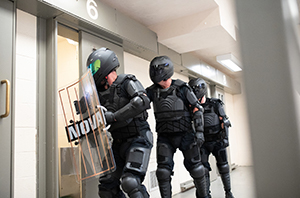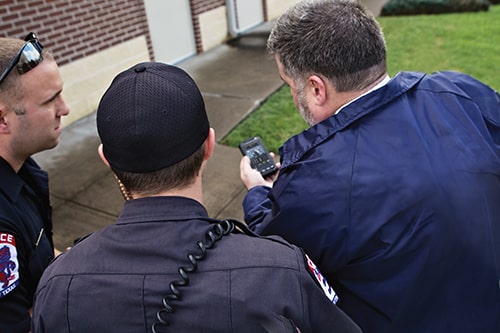Motorola Solutions partnered with the Center for Digital Government (CDG) to dive deeper into how agencies are approaching digital evidence management in 2022. In our last two blogs, we summarized a few highlights from the survey report and explored how agencies are approaching digital evidence management in the cloud. Today we will focus on what types of digital media the 100 agencies we surveyed would like their digital evidence management system to support.
Setting the stage: mobile video holds a large amount of influence
It’s safe to say that body cameras and in-car video play a huge role in an agency’s decision of which digital evidence management system to use. In fact, 63% of our 2022 survey respondents said it is “very important” that their digital evidence management system comes from the same provider as their body-worn cameras and other video equipment.
But mobile video footage is only a fraction of all the types of digital media available to agencies as they build their case. We set out to learn what other types of digital evidence agencies are looking for their evidence software to support.
Here are the most important types of digital evidence that respondents reported they want their digital evidence management system to manage:
1. Crime Scene Photos
49% of respondents said crime scene photos were the number one type of media they would like their digital evidence management system to support. Managing crime scene photos can be a multi-step and complicated process, usually falling into one of three categories:
- Photos are stored on a USB drive and put in someone’s desk until needed, causing chain of custody issues. This is also the least secure option.
- Photos are handled like physical evidence, downloaded onto physical storage devices and checked in and out of an evidence locker, which can be tedious and time consuming to access.
- Agencies use a dedicated digital evidence management system for crime scene photos, which makes it easier to access and track, but keeps crime scene photos separate from the other digital media associated with the incident.
Given these typical approaches, the appeal of managing crime scene photos within a shared digital evidence management system becomes obvious. Keeping multiple types of evidentiary content securely stored in a single system minimizes the effort to collect the content if needed, and minimizes the risk of evidence being overlooked when pursuing a case.
2. Evidence Captured with an Officer’s Mobile Phone
41% of respondents said evidence captured with an officer’s mobile phone was important to manage digitally. Capturing media with an officer’s phone can create a few challenges:
- If evidence is captured on an officer’s phone and this media becomes important for a case, the officer’s phone can be subpoenaed. For this reason, many officers are uncomfortable capturing evidence on their personal mobile devices.
- If an agency supplies officers with a dedicated mobile device, this certainly helps, but places additional financial burden on agencies with already limited resources.
- Agencies need to be able to prove the evidence on the mobile device has not been altered or tampered with in any way, as well as prove chain of custody.
Similar to crime scene photos, managing digital evidence captured on a mobile device as part of the larger digital evidence system makes a lot of sense. The risk of subpoena ‒ for personal or agency devices ‒ is real, so securely transitioning digital evidence off the device and into a DEMS as soon as possible minimizes that likelihood, and often provides proof of chain of custody as well.
3. Digital Documents
36% of respondents said they would like their digital evidence management system to support digital documents, such as PDFs. Similar to crime scene photos, many documents either have to be printed and physically stored, or stored in a different system from other types of digital evidence (such as an agency’s video management system).
Managing digital documents alongside other digital evidence in a single system increases efficiency, reduces the risk of such documents being overlooked for court proceedings, and makes life easier for overburdened agency staff.
4. Public Safety Answering Point (PSAP) Evidence
33% of respondents said they would like their digital evidence management system to support evidence from their PSAP. Citizens have the ability to send images or stream video to 9-1-1 callers in a controlled environment, which can give call takers additional insight into the incident.
When deciding whether or not to allow citizen media into the PSAP, agencies emphasize the need for stress mitigation and treatment surrounding acceptance of “incident related imagery”, as well as the importance of creating policies around when call takers should view citizen media. But thinking long term, it’s also important to consider how the agency will manage, tag, and utilize this evidence after the fact.
5. Evidence Submitted by the Public
30% of respondents said they need their DEMS to support evidence submitted by the public. It’s important for agencies to consider community engagement as a powerful addition to their digital evidence management program. However, agencies also need a way to accept or reject evidence submitted by the public. If accepted, these files need to be appropriately tagged and correlated to the incident in the digital evidence management system. Viewing citizen submitted evidence alongside the other pieces of media helps an agency build a more complete view of the case.
Check back as we dive deeper into the survey results
Did you miss the first two blogs in this series? Check out New Report: Strategies for Digital Evidence Management and 2022 Trends for Managing Digital Evidence in the Cloud. And check back here as we continue to explore the survey data in more detail.
Want the full report? Download New Strategies to Meet Demands for Digital Evidence Collection, Storage & Management here.




